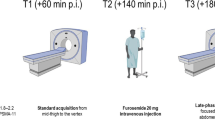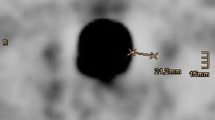Abstract
Purpose
to assess the influence of intravenous hydration and forced diuresis with furosemide in two different dosages (20 vs 40 mg) on the intensity of tracer accumulation in the urinary collection system and on the occurrence of halo artefact surrounding the urinary bladder and kidneys in [68Ga]Ga-PSMA-11-PET/CT scans.
Materials and methods
Comparison of four groups with 50 patients each, receiving different preparation prior to [68Ga]Ga-PSMA-11-PET/CT. Group one, no preparation. Group two, 500 ml sodium chloride administered immediately after tracer injection. Group three, 500 ml sodium chloride and injection of 20 mg furosemide immediately after tracer administration. Group four, 500 ml sodium chloride and injection of 40 mg furosemide immediately after tracer injection. Images were judged visually whether halo artefact was present; semiquantitative measurements were performed with standardised uptake value (SUV).
Results
Halo artefact of the urinary bladder was present in twelve patients without preparation, in eight patients receiving only sodium chloride, in one patient injected with 20 mg furosemide/sodium chloride and in two patients receiving 40 mg furosemide/sodium chloride, showing a median SUVmean in the bladder of 45.8, 14.4, 4.6 and 5.8, respectively. Differences between patient group without preparation and the two groups with furosemide/sodium chloride were statistically significant. Patient groups receiving 20 mg furosemide and 40 mg furosemide did not differ significantly. Renal halo artefacts were observed in 15 patients of group one, in ten patients of group two, in 14 patients of group three and in 14 patients of group four, with corresponding median SUVmean values of 33.9, 32.0, 37.8 and 30.4 (no statistically significant differences).
Conclusion
Performing [68Ga]Ga-PSMA-11-PET/CT, intravenous injection of 20-mg furosemide and 500-ml sodium chloride significantly reduces the number of bladder halo artefacts and intensity of tracer accumulation in the urinary bladder. A total of 40 mg furosemide does not further improve results.




Similar content being viewed by others
References
Afshar-Oromieh A, Holland-Letz T, Giesel FL, Kratochwil C, Mier W, Haufe S, et al. Diagnostic performance of 68Ga-PSMA-11 (HBED-CC) PET/CT in patients with recurrent prostate cancer: evaluation in 1007 patients. Eur J Nucl Med Mol Imaging. 2017;44:1258–68. https://doi.org/10.1007/s00259-017-3711-7.
Caroli P, Sandler I, Matteucci F, De Giorgi U, Uccelli L, Celli M, et al. 68Ga-PSMA PET/CT in patients with recurrent prostate cancer after radical treatment: prospective results in 314 patients. Eur J Nucl Med Mol Imaging. 2018;45:2035–44. https://doi.org/10.1007/s00259-018-4067-3.
Fendler WP, Calais J, Eiber M, Flavell RR, Mishoe A, Feng FY, et al. Assessment of 68Ga-PSMA-11 PET accuracy in localizing recurrent prostate cancer: a prospective single-arm clinical trial. JAMA Oncol. 2019;5:856–63. https://doi.org/10.1001/jamaoncol.2019.0096.
Virgolini I, Decristoforo C, Haug A, Fanti S, Uprimny C. Current status of theranostics in prostate cancer. Eur J Nucl Med Mol Imaging. 2018;45:471–95. https://doi.org/10.1007/s00259-017-3882-2.
Uprimny C. Ga-PSMA-11 PET/CT: the rising star of nuclear medicine in prostate cancer imaging? Wien Med Wochenschr. 2019;169:3–11. https://doi.org/10.1007/s10354-017-0569-z.
Fendler WP, Eiber M, Beheshti M, Bomanji J, Ceci F, Cho S, et al. Ga-PSMA PET/CT: joint EANM and SNMMI procedure guideline for prostate cancer imaging: version 1.0. Eur J Nucl Med Mol Imaging. 2017;44:1014–24. https://doi.org/10.1007/s00259-017-3670-z.
Afshar-Oromieh A, Malcher A, Eder M, Eisenhut M, Linhart HG, Hadaschik BA, et al. PET imaging with a [68Ga]gallium-labelled PSMA ligand for the diagnosis of prostate cancer: biodistribution in humans and first evaluation of tumour lesions. Eur J Nucl Med Mol Imaging. 2013;40:486–95. https://doi.org/10.1007/s00259-012-2298-2.
Fanti S, Minozzi S, Morigi JJ, Giesel F, Ceci F, Uprimny C, et al. Development of standardized image interpretation for 68Ga-PSMA PET/CT to detect prostate cancer recurrent lesions. Eur J Nucl Med Mol Imaging. 2017;44:1622–35. https://doi.org/10.1007/s00259-017-3725-1.
Afshar-Oromieh A, Haberkorn U, Schlemmer HP, Fenchel M, Eder M, Eisenhut M, et al. Comparison of PET/CT and PET/MRI hybrid systems using a 68Ga-labelled PSMA ligand for the diagnosis of recurrent prostate cancer: initial experience. Eur J Nucl Med Mol Imaging. 2014;41:887–97. https://doi.org/10.1007/s00259-013-2660-z.
Hofman MS, Hicks RJ, Maurer T, Eiber M. Prostate-specific membrane antigen PET: clinical utility in prostate cancer, normal patterns, pearls, and pitfalls. Radiographics. 2018;38:200–17. https://doi.org/10.1148/rg.2018170108.
Freitag MT, Radtke JP, Afshar-Oromieh A, Roethke MC, Hadaschik BA, Gleave M, et al. Local recurrence of prostate cancer after radical prostatectomy is at risk to be missed in 68Ga-PSMA-11-PET of PET/CT and PET/MRI: comparison with mpMRI integrated in simultaneous PET/MRI. Eur J Nucl Med Mol Imaging. 2017;44:776–87. https://doi.org/10.1007/s00259-016-3594-z.
Giesel FL, Will L, Lawal I, Lengana T, Kratochwil C, Vorster M, et al. Intraindividual comparison of 68Ga-PSMA-11-PET/CT and multiparametric MR for imaging of primary prostate cancer. J Nucl Med. 2018;59:1076–80. https://doi.org/10.2967/jnumed.117.204669.
Uprimny C, Kroiss AS, Fritz J, Decristoforo C, Kendler D, von Guggenberg E, et al. Early PET imaging with [68]Ga-PSMA-11 increases the detection rate of local recurrence in prostate cancer patients with biochemical recurrence. Eur J Nucl Med Mol Imaging. 2017;44:1647–55. https://doi.org/10.1007/s00259-017-3743-z.
Heußer T, Mann P, Rank CM, Schäfer M, Dimitrakopoulou-Strauss A, Schlemmer HP, et al. Investigation of the halo-artifact in 68Ga-PSMA-11-PET/MRI. PLoS One. 2017;12:e0183329. https://doi.org/10.1371/journal.pone.0183329.
Wangerin KA, Baratto L, Khalighi MM, Hope TA, Gulaka PK, Deller TW, et al. Clinical evaluation of 68Ga-PSMA-11 and 68Ga-RM2 PET images reconstructed with an improved scatter correction algorithm. AJR Am J Roentgenol. 2018;211:655–60. https://doi.org/10.2214/AJR.17.19356.
Lawhn-Heath C, Flavell RR, Korenchan DE, Deller T, Lake S, Carroll PR, et al. Scatter artifact with Ga-68-PSMA-11 PET: severity reduced with furosemide diuresis and improved scatter correction. Mol Imaging. 2018;17:1536012118811741. https://doi.org/10.1177/1536012118811741.
Prasad V, Steffen IG, Diederichs G, Makowski MR, Wust P, Brenner W. Biodistribution of [(68)Ga]PSMA-HBED-CC in patients with prostate cancer: characterization of uptake in normal organs and tumour lesions. Mol Imaging Biol. 2016;18:428–36. https://doi.org/10.1007/s11307-016-0945-x.
Afshar-Oromieh A, Wolf M, Haberkorn U, Kachelrieß M, Gnirs R, Kopka K, et al. Effects of arm truncation on the appearance of the halo artifact in. Eur J Nucl Med Mol Imaging. 2017;44:1636–46. https://doi.org/10.1007/s00259-017-3718-0.
Fennessy N, Lee J, Shin J, Ho B, Ali SA, Paschkewitz R, et al. Frusemide aids diagnostic interpretation of 68Ga-PSMA positron emission tomography/CT in men with prostate cancer. J Med Imaging Radiat Oncol. 2017;61:739–44. https://doi.org/10.1111/1754-9485.12625.
Haupt F, Dijkstra L, Alberts I, Sachpekidis C, Fech V, Boxler S, et al. Ga-PSMA-11 PET/CT in patients with recurrent prostate cancer-a modified protocol compared with the common protocol. Eur J Nucl Med Mol Imaging. 2020;47:624–31. https://doi.org/10.1007/s00259-019-04548-5.
Afshar-Oromieh A, Sattler LP, Mier W, Hadaschik BA, Debus J, Holland-Letz T, et al. The clinical impact of additional late PET/CT imaging with 68Ga-PSMA-11 (HBED-CC) in the diagnosis of prostate cancer. J Nucl Med. 2017;58:750–5. https://doi.org/10.2967/jnumed.116.183483.
Derlin T, Weiberg D, von Klot C, Wester HJ, Henkenberens C, Ross TL, et al. Ga-PSMA I&T PET/CT for assessment of prostate cancer: evaluation of image quality after forced diuresis and delayed imaging. Eur Radiol. 2016;26:4345–53. https://doi.org/10.1007/s00330-016-4308-4.
Perveen G, Arora G, Damle NA, Prabhu M, Arora S, Tripathi M, et al. Can early dynamic positron emission tomography/computed tomography obviate the need for postdiuresis image in 68Ga-PSMA-HBED-CC scan for evaluation of prostate adenocarcinoma? Indian J Nucl Med. 2018;33:202–8. https://doi.org/10.4103/ijnm.IJNM_32_18.
Uprimny C, Kroiss AS, Decristoforo C, Fritz J, von Guggenberg E, Kendler D, et al. Ga-PSMA-11 PET/CT in primary staging of prostate cancer: PSA and Gleason score predict the intensity of tracer accumulation in the primary tumour. Eur J Nucl Med Mol Imaging. 2017;44:941–9. https://doi.org/10.1007/s00259-017-3631-6.
Kruskal WH, Wallis WA. Use of ranks in one-criterion variance analysis. J Am Stat Assoc. 1952;47:583–621. https://doi.org/10.1080/01621459.1952.10483441.
Dunn OJ. Multiple comparisons using rank sums. Technometrics. 1964;6:241–52. https://doi.org/10.1080/00401706.1964.10490181.
Holm S. A simple sequentially rejective multiple test procedure. Scand J Stat. 1979;6:65–70.
Scheirer CJ, Ray WS, Hare N. The analysis of ranked data derived from completely randomized factorial designs. Biometrics. 1976;32:429–34. https://doi.org/10.2307/2529511.
R Core Team. R: A language and environment for statistical computing. Austria: Vienna: R Foundation of Statistical Computing; 2018. https://www.r-project.org/
Gaertner FC, Beer AJ, Souvatzoglou M, Eiber M, Fürst S, Ziegler SI, et al. Evaluation of feasibility and image quality of 68Ga-DOTATOC positron emission tomography/magnetic resonance in comparison with positron emission tomography/computed tomography in patients with neuroendocrine tumors. Investig Radiol. 2013;48:263–72. https://doi.org/10.1097/RLI.0b013e31828234d0.
Silver DA, Pellicer I, Fair WR, Heston WD, Cordon-Cardo C. Prostate-specific membrane antigen expression in normal and malignant human tissues. Clin Cancer Res. 1997;3:81–5.
Association WM. World Medical Association Declaration of Helsinki: ethical principles for medical research involving human subjects. JAMA. 2000;284:3043–5.
Acknowledgements
We want to express our gratitude to all the members of our PET staff for their contribution in performing this study.
Author information
Authors and Affiliations
Corresponding author
Ethics declarations
Conflict of interest
The authors declare that they have no conflict of interest.
Ethical approval
All procedures performed in this study were in accordance with the ethical standards of the institutional and national research committee and with the principles of the 1964 Declaration of Helsinki and its subsequent amendments [32]. In accordance with our local regulations, ethical approval was waived, as the study was conducted retrospectively from data obtained for clinical purposes. Written informed consent was obtained from all patients prior to the exam, and the retrospective study was conducted according to institutional guidelines and is in compliance with the specific requirements of our country.
Additional information
Publisher’s note
Springer Nature remains neutral with regard to jurisdictional claims in published maps and institutional affiliations.
This article is part of the Topical Collection on Oncology - Genitourinary
Rights and permissions
About this article
Cite this article
Uprimny, C., Bayerschmidt, S., Kroiss, A.S. et al. Impact of forced diuresis with furosemide and hydration on the halo artefact and intensity of tracer accumulation in the urinary bladder and kidneys on [68Ga]Ga-PSMA-11-PET/CT in the evaluation of prostate cancer patients. Eur J Nucl Med Mol Imaging 48, 123–133 (2021). https://doi.org/10.1007/s00259-020-04846-3
Received:
Accepted:
Published:
Issue Date:
DOI: https://doi.org/10.1007/s00259-020-04846-3




